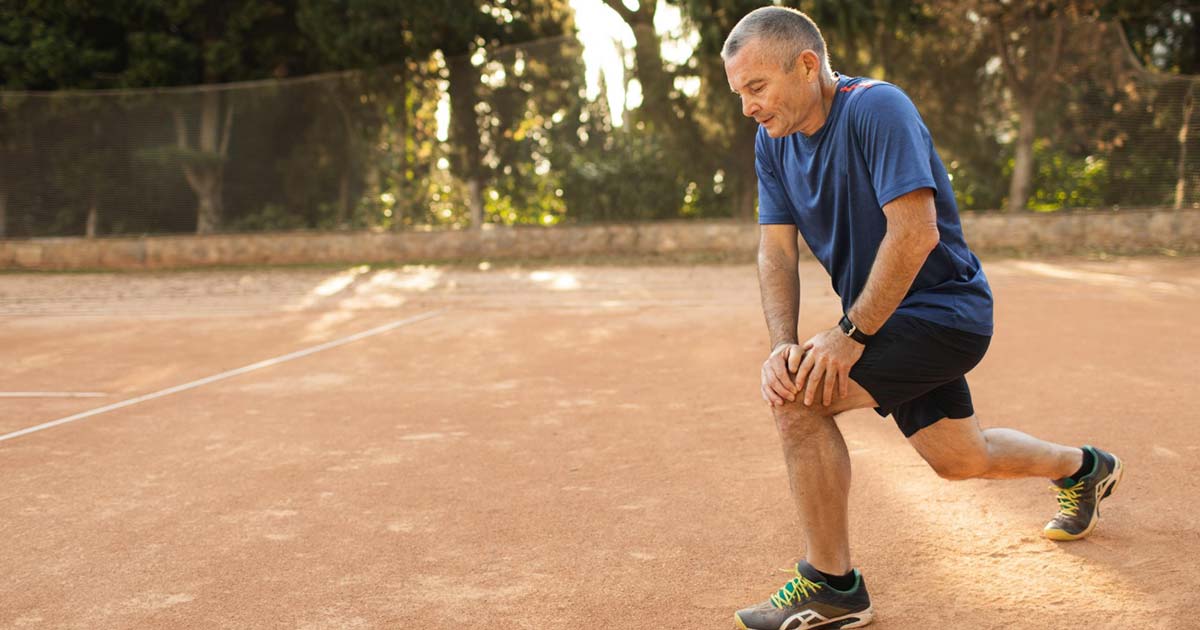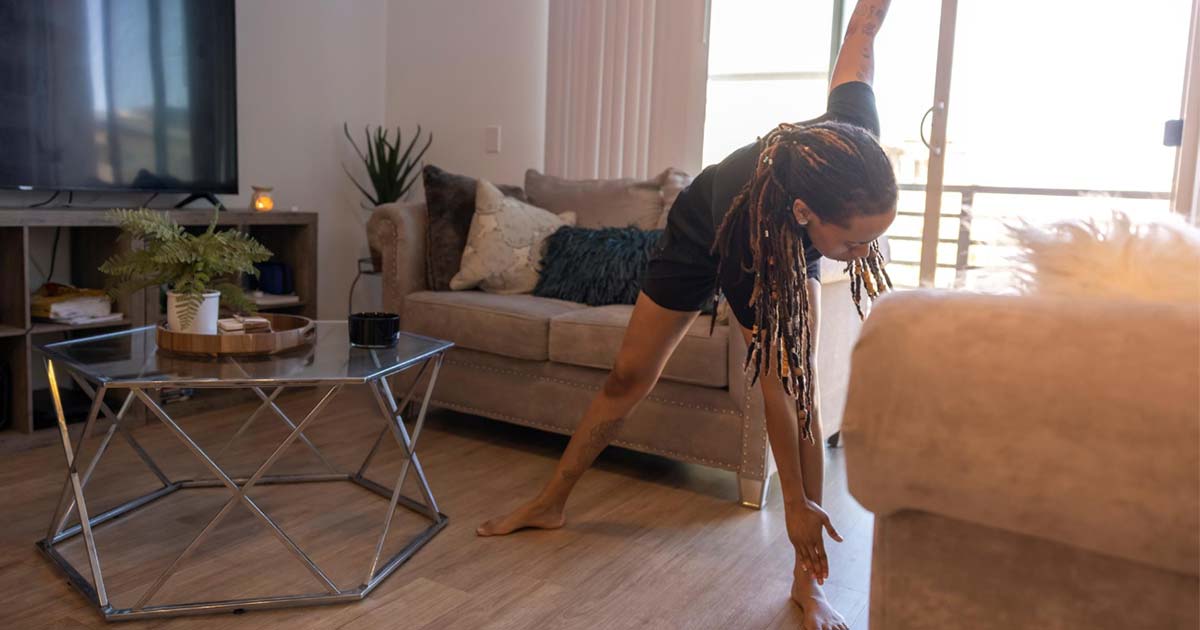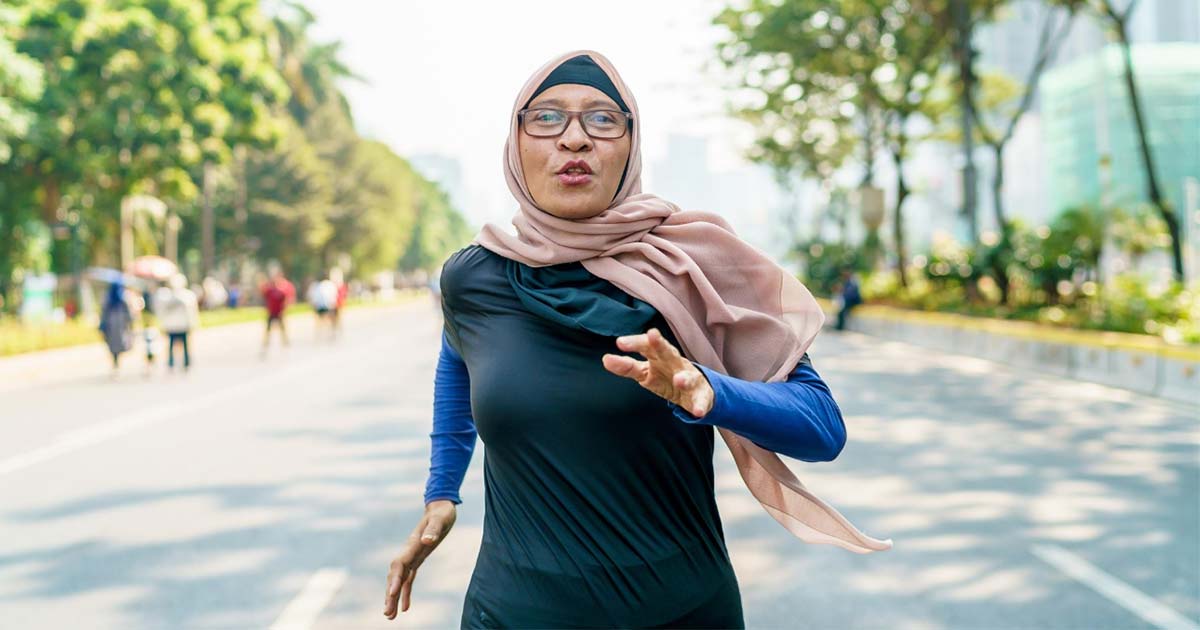
Advice to improve your movement, fitness, and overall health from the #1 in orthopedics in the U.S.
Move with Purpose to Combat Upper and Lower Cross Syndromes
Working from home can take a toll on your body, in the form of upper cross syndrome and lower cross syndrome. Learn how to move in ways that are better for your body.
Advice to improve your movement, fitness, and overall health from the #1 in orthopedics in the U.S.

Avoid "Cross Syndrome"
Inactivity and poor posture are breeding grounds for cross syndrome, which develops when muscles in one part of the body become overstretched and weak while muscles in the opposing part become overworked, short and tight.
- Upper body cross syndrome happens when you are chronically hunched. The muscles of the upper back, shoulders and neck — particularly the middle trapezius and lower trapezius muscles — tend to get long and weak, while the upper trapezius and levator scapula muscles become overworked and tight. The muscles of the chest also become tight, pulling the shoulders forward. You may feel neck and shoulder discomfort and even experience headaches.
- Lower body cross syndrome happens with prolonged sitting. The abdominal and gluteal muscles become long and weak, while the low back muscles and hip flexors (muscles at the front of your hips which you use to move your legs) become short and tight. You may experience lower back pain as well as tightness and reduced mobility in the hips.
In both cases, the goal is to stretch the short, tight muscles while strengthening the weak ones. Moving frequently during the day also helps promote blood flow to the muscles and lubricates the joints. If you are working from home or planning to do so more often than you used to, invest in an ergonomic work setup that includes a desk of a suitable height and a supportive desk chair. Try setting up your computer so your monitor is straight in front of you, so you don't have to look down at it. (The top of your monitor should be even with your eyes.)
Focus on Your Core
When you hear the word "core," you may think of strong abdominal muscles. But your core is so much more than that. It includes your arms, legs and head, all moving together over a strong base that includes the muscles in your back, abdomen and pelvic floor, as well as one of the least appreciated muscles: your diaphragm. This large muscle in your midsection extends from the front to the back of your body. In addition to being a critical moving part during respiration, it is an important stabilizer for your body when you are exercising.
Ideally, you want to move as much as possible in a neutral position while maintaining a strong core. This means your head is over your shoulders, which are over your hips, which are over your knees and ankles, with no part of your body too far forward or back. While abdominal strengthening exercises such as Pilates can build a strong core, strengthening the other parts of your body is just as important to achieve and maintain balance.
When you are squatting or lifting, think about your body's alignment. While squatting, avoid letting your knees extend too far forward; you should still be able to see your toes when you look down. When squatting to lift, get as close to the object as you can, pull it close to your body and use your glutes and hips to drive your body upward, rather than lifting with your arms or back. A strong core will make this task easier.
Moving Correctly While Being Comfortable
There is no one good posture that is perfect for any length of time and for every body. The best thing to do is to keep moving. Here are some ways to do that:
- Drink water often throughout the day; it not only helps keep you hydrated, but it means you'll need to get up more often to use the bathroom.
- Set an alarm on your phone to remind you to get up and move or stretch. There are even apps that help you schedule movement breaks.
- Make exercise a priority. Schedule physical activity into your day the same way you schedule anything else, even if it's a 20-minute walk at lunchtime.
It's also possible to achieve a neutral position when you sleep.
- If you're a back sleeper, you may find support in placing a light pillow under your knees, which takes pressure off your lower back.
- If you're a side sleeper, placing a pillow between your knees can provide added support.
- If you're a stomach sleeper, pay attention to areas of strain on your body and find the most comfortable and balanced position for you.
If you have problems with joint discomfort, speak with your doctor or an occupational or physical therapist regarding splints and braces that can provide support and relieve the stress on cranky wrists, knees or ankles.
Stretch It Out
In addition to cardio and strength workouts, flexibility is a critical component of any good exercise routine — but many people overlook it. Stretching relaxes those tight muscles that have become shortened as a result of upper or lower cross syndrome.
Dynamic stretching, such as leg swings and arm circles, are a good way to gently stretch the muscles and improve blood flow before you start exercising. After your workout, static stretching helps you cool down and stretch the muscle while it is warm after all the exercise you've done. Hold each stretch for at least 20 to 30 seconds; it's longer than most people think, but necessary to obtain the most benefit from the stretch. Learn about static and dynamic stretches.
You can incorporate various devices into your stretching routine to achieve different results and change up your game a bit:
- Foam rollers and massage balls are excellent for soft tissue/muscle massage after a workout. They help bring fresh blood to your muscles.
- Straps, such as yoga straps, can help you stretch your arms, shoulders, legs and hips while supporting those parts of your body.
- Thera Cane is a device shaped like a cane with knobs in key locations to help you massage different parts of your body, including hard-to-reach areas of your back.
Be careful not to overdo it, though. A good stretch should give you a strong sensation but should not cause the kind of pain that makes you say "ouch!"
Yoga, t'ai chi and Pilates provide various types of stretching. There are even "stretch labs" — places you can go to have a certified trained professional work with you to devise a customized stretching program, with assisted stretching provided at their location.
Making Progress
Your body will tell you when you're moving more effectively and comfortably, so listen carefully. Ask yourself these questions to assess your progress:
- Can you sit through a 30-minute meeting now before your back starts to ache, when it used to start hurting after only 15 minutes?
- Can you now ride in a car for an hour before your lower back pain starts to flare up, whereas you used to feel it much sooner?
- Are you noticing that you don't need to set alarms anymore to correct your posture or get up and move because it's become a habit?
These are some excellent ways to increase your awareness of moving with purpose. With practice and commitment, you can get there.
This article is brought to you by Community Education & Outreach.
Published 8/29/2021


